
The European market potential for tomatoes
The European production of tomatoes is decreasing due to high production costs. This creates opportunities for non-European suppliers. Opportunities for suppliers from developing country can be found in large markets such as Germany, France and the United Kingdom, especially during winter in Europe. New suppliers must be able to compete with producers from Spain and Morocco. Sweet tomatoes with a firm texture, dark-coloured ribbed tomatoes, cocktail tomatoes, plum cherry and traditional sweet varieties are popular.
Contents of this page
1. Product description
The tomato is the edible berry of the plant Solanum lycopersicum. Tomatoes are the world’s most popular vegetable. They represent nearly 20% of all produced vegetables. Globally, the annual production of fresh tomatoes is approximately 180 million tonnes. There are more than 10,000 tomato cultivars (kinds of tomatoes). Most of them are used for fresh consumption, but nearly a quarter of them are used for processing (juices, canning, purees, sauces and ketchup). This study will only discuss the European market for tomatoes for fresh consumption.
Figure 1: Round tomato
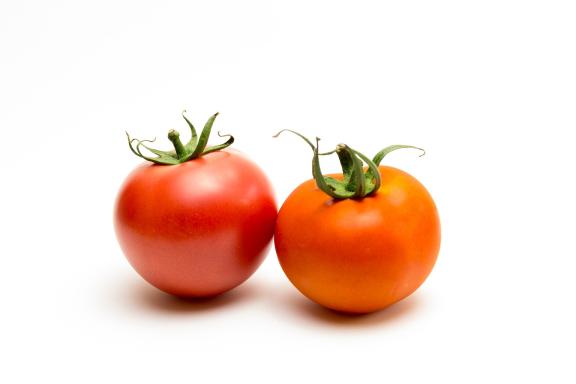
Source: Pixabay (image by Antonio Jose Cespedes)
Figure 2: Ribbed tomato
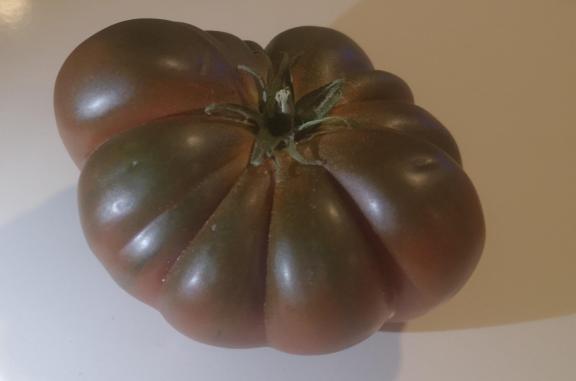
Source: Autentika Global
Figure 3: Oblong or elongated tomato (also known as plum tomato)
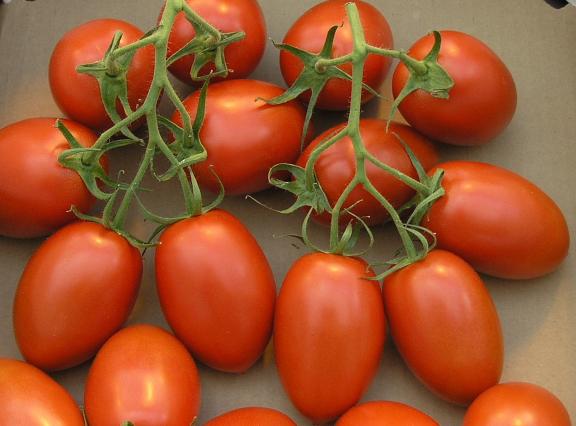
Source: Wikimedia Commons (licence CC BY-SA 3.0, image by Goldlocki)
Figure 4: Cherry/cocktail tomatoes (miniature varieties)
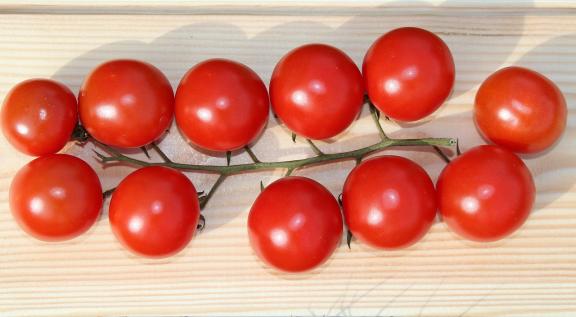
Source: Pixabay (image by Alicja)
Some large producing countries specialise in the production of tomatoes on open fields for processing, such as the USA and Italy. Figure 5 shows the official data for leading global producers of tomatoes and their share of fresh and processing output. However, this data is not reliable because some countries fail to report the annual output precisely. Although there is no official information, it can be estimated that the leading suppliers of tomatoes aimed for fresh consumption are Mexico, Spain, Morocco, Turkey and the Netherlands.
Source: World Processing Tomato Council (august 2023) and FAO
This study covers general information about the fresh tomato market in Europe, which is of interest to producers in developing countries. For statistical analysis, the following combined harmonised system code is used:
| Harmonised system code | Product |
| 070200 | Tomatoes, fresh or chilled |
When this study refers to ‘Europe’, it includes the 27 member states of the European Union, plus the United Kingdom, Switzerland, Norway, Iceland and Liechtenstein. Developing countries are defined as the countries that are listed as official development assistance recipients.
2. What makes Europe an interesting market for fresh tomatoes?
Although Europe is the world’s third largest producer of tomatoes, local demand is still higher than domestic production. Over the last five years, total imports have remained relatively stable. They reached 3.2 million tonnes in 2022. Over the same period, the imported value increased by an annual rate of 7%, reaching €5.6 billion. This increase in value is the result of a sharp rise in energy costs, due to the war in Ukraine, which led to an increase in import prices.
Over the next five years, the European market for fresh tomatoes is likely to increase with an annual growth rate of 1–3%. This estimation is based on the constant increase in consumption of fresh produce due to healthy living trends. However, the structure of trade might change. The increase in imports from developing countries is also likely to continue. For example, the tomato crop in Europe in 2022 was about 10% lower than in 2021, and imports from developing countries increased by 77,000 tonnes (7%).
Source: ITC TradeMap and Eurostat
The best opportunities for non-European suppliers can be found in the off-season for domestic supply in Europe, during the winter months. Fresh tomato imports to Europe from non-European countries have a strong seasonal nature, peaking between December and February. In winter, production in most European countries (except South Europe) is limited to heated and lit greenhouses. In 2022, many producers also stopped energy-intensive winter production due to the sharp rise in energy prices following Russia’s invasion of Ukraine.
Another reason for developing country suppliers to target the European winter months in their tomato offers is to avoid high tariff duties. The European Union applies seasonal tariffs and tariff quotas to protect domestic production. Typically, the lowest duties are applied for tomatoes imported from 1 October to 31 May, but this depends on the specific trade agreements for each individual country.
Most suppliers enter the European market with relatively low prices, but price competitiveness is not the only reason for increasing imports from developing countries. There is also increasing demand for sustainably produced tomatoes (e.g. organic), attractive cultivars (e.g. vine tomatoes, and miniature, yellow and purple varieties) and natural ripening, which improves the taste.
Tip:
- Target the harvesting and shipping time for the period between December and February to increase your opportunities on the European market. Cooperate with skilful agronomists to choose the right cultivars and moment for planting.
3. Which European countries offer the most opportunities for fresh tomatoes?
The European market for fresh tomatoes is moderately concentrated. Three countries make up half of the total imports. In 2022, Germany was the leading importer in Europe (20% import share), followed by France (18%), the United Kingdom (12%), the Netherlands (8%) and Spain (6%). Over the last five years, France has significantly increased imports from developing countries. French imports from developing countries increased from 327,000 tonnes in 2018 to 434,000 tonnes in 2022.
According to the European Commission’s short-term outlook, consumption of fresh tomatoes (excluding processing) in the EU was more than seven million tonnes. Per capita consumption was 15.6 kg. European production in 2022 was more than six million tonnes, which means that around 15% of European demand is made up of imports.
Source: Autentika Global (compilation based of FAO, WPTC and EU Fruit and Vegetables Market Observatory data, August 2023)
Leading consuming and importing countries in Europe do not offer equal opportunities for suppliers from developing countries. Spain, the top European consumer, satisfies local demand from its own production. As the leading European supplier, Spain also imports tomatoes through sub-contracting and serves as a transit country for other European markets. Italy, the second largest consumer in Europe, mostly consumes tomatoes produced in Europe.
Source: ITC TradeMap and Eurostat
Opportunities in European fresh tomatoes markets can be roughly classified in the following way:
- Markets that do not have sufficient local production and mostly depend on imports. The largest markets of this type are Germany, France and the UK. Northern Europe cannot produce sufficient quantities for its own consumption due to unfavourable climate conditions. As these markets are also the leading importers, you can expect high competition and a large number of players.
- Markets with a high share of imports from non-European countries, such as Bulgaria, Romania and Austria. These countries offer good opportunities, but price competitiveness is very important as they import relatively cheap tomatoes from Turkey.
- Opportunities for some serious suppliers can be found in subcontracting with leading suppliers such as Spain and the Netherlands.
Germany: the largest European importer of fresh tomatoes
Tomatoes are the most popular vegetable in Germany. German households purchased an average of 13.5 kg of tomatoes in 2021, ahead of cucumbers (10.6 kg) and carrots (10.4 kg). Tomatoes represent around 15% of the retail sales of all vegetables sold in Germany.
Germany is the largest importer of fresh tomatoes in Europe, with around 20% market share. German tomato imports fluctuated over the last five years, reaching 633,000 tonnes and a value of €1.46 billion in 2022. Of this quantity, imports from developing countries accounted for 14%. Germany is also an exporter and producer of tomatoes. However, in terms of exports, Germany mostly acts as a transit country for tomato suppliers from other origins. In 2022, Germany exported 23,000 tonnes of tomatoes to other European countries.
In 2022, Germany imported 46% of its tomatoes from the Netherlands, followed by Spain (24%) and Morocco (11%). Although the German share of imports from developing countries is less than 15%, it is increasing. Imports from Morocco have increased by almost 30,000 tonnes since 2018. During the same period, imports from Turkey increased threefold, from 5,000 tonnes in 2018 to almost 16,000 tonnes in 2022. Another developing country with a growing German market share is Tunisia, although it makes up a very small share (<1%).
Around half of the fresh tomatoes in Germany are sold through discounters, followed by mainstream supermarkets. Less than 5% is sold through independent shops, ethnic stores and open-air markets. Most retailers purchase tomatoes from European traders and packers. However, some retailers are in the process of developing direct sourcing programmes. One example is the German retail chain Edeka, which is developing direct sourcing through a specialised logistical network (Edeka Fruchtkontor) that has a presence in Germany, the Netherlands, Spain and Italy.
Figure 9: Selection of tomatoes in an open green market in Munich
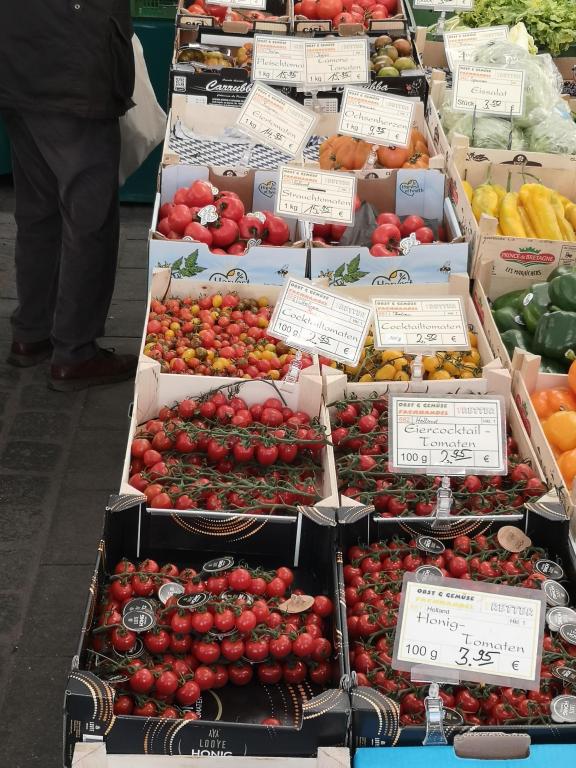
Source: Autentika Global
The retail chain Lidl currently sells the most imported tomatoes in Germany. Lidl is present in every European country, but tomato purchasing often goes through Germany. This explains its dominant position in the market. Large quantities of tomatoes in Germany are sold under private labels (e.g. NATUR Lieblinge by Aldi Süd) or unbranded (unpacked). However, some suppliers have managed to establish a strong presence of their own brands, such as San Lucar, which pack and sell tomatoes from Spain, Germany, the Netherlands and Tunisia.
Some notable examples of tomato importers in Germany include Juan Garcia Lax, CONTI-FRUCHT Busam, Gemüsering Stuttgart and OGL – Food Trade. Some importers also sell locally produced tomatoes in the summer months. One example of a local supplier is Reichenspurner Hof, which grows tomatoes, strawberries and bell peppers in 200,000 m3 greenhouses. Several German importers subcontract packing operations in the Netherlands before selling tomatoes to retail chains in Germany.
Germany is a particularly attractive market for organic tomatoes, as the country is the largest European market for organic food. In 2022, the German organic market had a value of €15.3 billion. It is estimated that around 6% of tomatoes in Germany are sold as organic. There are over 2,400 organic food retail shops in Germany. Biomarkt is the leading organic retailer, followed by Alnatura. Organic tomatoes are also sold in mainstream retail chains, with the strongest sale increase in discounters like Lidl and Aldi. Most are of Spanish or local origin.
Tips:
- Read information about the German tomato market in the specialised online trade magazine Fruchthandel (only available in German).
- Use a browser translation function like Google Translate to read the information in your own language.
France: a strong off-season supply from Morocco
Over the last five years, the French import of fresh tomatoes has increased at an annual rate of 2%. It reached 570,000 tonnes in 2022, worth €904 million. France is also a strong re-exporter of tomatoes, mostly from Morocco. In 2022, France exported 324,000 tonnes of tomatoes, mainly to Germany and the Netherlands. France is also an important producer of tomatoes. Depending on the season, France produces between 700,000 and 800,000 tonnes. Around 20% of this quantity is used for processing.
The import of tomatoes is seasonal in character, peaking during the European winter months. More than 80% of tomatoes are imported into France between November and March. During the rest of the year, French retailers support local production and often use a label to promote the local origin (‘Tomates de France’). This label was created by the National Association of Tomato and Cucumber Producers with the aim of protecting 500 local producers.
Morocco is the leading supplier of imported tomatoes to France, with a 75% market share in 2022. Spain (14%), Belgium (4%) and the Netherlands (3%) follow. Morocco’s dominant position is the result of French investments and subcontracting operations. The largest share of the Moroccan tomato supply to France is held by the Lymouna-Matysha group, which has its own distribution centre in the south of France. Other developing country suppliers are Tunisia, Turkey and the Dominican Republic.
Most tomatoes in France are sold through retail channels. Large quantities are sold under private labels or unpacked. The leading points of sales are retail chains such as Carrefour, Leclerc, Système U, Intermarché and Auchan. There are many producers, traders and packers that supply these supermarkets. Notable examples include TerreAzur (part of the Pomona group) and Greenyard Fresh France. France also provides good opportunities for organic tomatoes as the second-largest organic market in Europe.
Tips:
- Visit Rungis, the largest wholesale market in Europe to get in touch with various traders of tomatoes.
- Check the member list of the National Syndicate of Fruit and Vegetable Importers and Exporters (SNIFL) to find tomato importers.
The United Kingdom: a large market with many small traders
In 2022, the United Kingdom imported 389,000 tonnes of fresh tomatoes, with a value of €373 million. Most imported tomatoes are consumed within the country. The percentage of re-exports is insignificant and goes mostly to Ireland. The imported quantity is topped up with domestic production of around 70,000 tonnes. Some of the leading suppliers of locally produced tomatoes include the APS Group, which is responsible for around 30% of the total UK production, and Thanet Earth.
The UK import market for tomatoes is very concentrated. The three leading suppliers (Morocco, the Netherlands and Spain) account for nearly 90% of the total tomato imports. Morocco has gained most of the UK market share, reaching a 37% share (14,400 tonnes), overtaking the Netherlands in 2022. The Netherlands was traditionally the leading supplier of tomatoes to the UK. However, the country dropped down to second place with a 32% market share, followed by Spain (19%), Belgium (6%) and Poland (3%).
Most of the tomato market share in the UK is taken up by retail chains’ private labels, such as those of Tesco, Sainsbury’s, ASDA and Morrisons. Discounters like Lidl and Aldi are increasing tomato sales. There are very few independent brands. Most retailers do not import tomatoes directly but purchase tomatoes from UK traders. However, direct sourcing is increasing. For example, the retail chain Morrisons is in the process of developing direct sourcing from European suppliers.
A specific feature of fresh tomato imports in the United Kingdom is the presence of a large number of smaller importers. The UK is thought to be home to more than 300 tomato importers. Some specialise in supplying the leading retail chains, some have only a regional presence and some import tomatoes as ingredients for their own mixed salads and freshly prepared food. Several Dutch suppliers also have packing houses and trade offices in the UK.
The market in the United Kingdom offers specific opportunities for suppliers of Fairtrade certified tomatoes, as the country is home to one of the largest Fairtrade products markets in Europe. According to recent research by The Fairtrade Foundation, alongside retail analysts Kantar, 77% of UK consumers prefer Fairtrade products over other alternatives. One example is the British company Keeling’s, which sources Fairtrade certified tomatoes from Morocco.
Tip:
- Contact Fresh Produce Consortium to find out more about UK trends in tomato trade.
The Netherlands: a producer and logistics hub for tomatoes
The Netherlands is the third largest producer of tomatoes in Europe, specialised in high-tech greenhouse production. It is home to several innovative tomato breeding companies. However, the Netherlands is also the fourth largest importer of fresh tomatoes. It acts as a re-exporter and logistics hub suitable for subcontracted production for competitive tomato suppliers.
Fresh tomato imports into the Netherlands have increased at an average annual rate of 2% since 2018. Imports reached more than 252,000 tonnes and a value of €391 million in 2022. A large share of these imported tomatoes are re-exported to other European countries. In 2022, the Netherlands exported more than 900,000 tonnes of locally produced and imported tomatoes. Germany and the UK are the main target markets for Dutch tomatoes.
In 2022, the Netherlands imported 22% of its fresh tomatoes from Spain, followed by France (20%), Belgium (17%) and Morocco (12%). Tunisia and Turkey are developing countries with growing market shares in the Netherlands. Turkey is increasing its export to the Netherlands fastest. Over the last five years, Dutch imports from Turkey increased fourfold, from 1,300 tonnes in 2018 to 5,800 tonnes in 2022.
Most fresh tomatoes in the Netherlands are sold under private labels or unpacked. The leading retail chains selling tomatoes under their own labels in the Netherlands are Albert Heijn, Jumbo, Lidl, Spar and Aldi. Some suppliers have managed to sell tomatoes under their own labels such as Prominent Tomatoes by Growers United Maasdijk or Honey (Honing) tomatoes by Looye Kwekers. Still, it should be emphasised that most imported tomatoes to the Netherlands are intended for re-export.
The Netherlands is home to several packing companies where suppliers from other countries pack tomatoes for further distribution. One of the most famous logistical spots is Fresh Park Venlo. It is Europe’s largest fresh food hub with more than 100 companies engaged in the business of fresh fruit and vegetables. As it is located near the German border, it is also convenient for German trading and packing companies.
There are many Dutch tomato producing and trading companies. A few examples of companies specialised in supplying retail chains directly are Harvest House, Looye Kwekers, RedStar, Frankort & Koning (50% owned by Total Produce) and EFP International B.V..
The Netherlands is a very attractive market for Fairtrade certified tomato suppliers. Although the general Fairtrade market in the Netherlands is smaller compared to Germany, France or the United Kingdom, it has several Fairtrade traders specialised in the tomato trade. Examples include Agro Care Projecten BV, Agro Fair Benelux BV and Plus Retail BV.
Tip:
- Find importers of fresh tomatoes on the list of members of the GroentenFruitHuis (Fresh Produce Centre).
Spain: competitor and subcontractor
Spain is the leading European producer and exporter of fresh tomatoes. Spain is an importer of tomatoes and a transit country to other European countries. Exporting fresh tomatoes to Spanish consumers directly is almost impossible, but it is possible to subcontract production with some of the Spanish suppliers. You can read more about Spanish production in the market entry part of this study.
In 2022, Spain imported 177,000 tonnes of tomatoes. Most of the imported tomatoes came from Morocco (44%), followed by Portugal (28%), the Netherlands (14%) and Belgium (7%). Fresh tomatoes are mostly sold as private labels of Spanish retail chains, such as Mercadona, Carrefour, Lidl, Alcampo, Eroski, Dia and Aldi. Open-air markets and traditional grocery shops are still valued in Spain, representing up to 30% of total fresh produce sales.
Offering organic or pesticide-free tomatoes can increase your opportunities on the Spanish market. Most of the tomato production in Almeria follows integrated pest management practices and minimal pesticide use. The Spanish company Zerya has created its own certification system for residue-free products. Under the ZERYA standard, ‘residue free’ means that any active ingredient is determined under 0.01 ppm when analysed.
Eastern Europe: increasing import from Turkey
Bulgaria and Romania import fresh tomatoes at a stable rate. In 2022, Bulgaria imported 90,000 tonnes of fresh tomatoes. Romania imported slightly less: 84,000 tonnes. Turkey is the main supplier to both countries. In both countries, more than 60% of imported tomatoes come from Turkey. Other emerging suppliers to Eastern Europe are Albania, Serbia and North Macedonia.
4. Which trends offer opportunities or pose threats on the European fresh tomatoes market?
Current inflation and the increasing demand for healthy and sustainable food are polarising the European tomato market. On one hand, consumers like cheap tomatoes like the regular round varieties (often imported from non-European countries). On the other hand, demand for sustainably produced tomatoes and attractive cultivars has resulted in the development of a luxury segment. It is not yet clear if these developments will deepen the gap between the cheap and luxury segment or result in price cuts throughout the supply chain.
Increasing import of tomatoes due to high energy prices
Due to the sharp rise in energy prices following Russia’s invasion of Ukraine, many tomato producers have stopped energy-intensive winter production. In 2022, the European production of tomatoes for fresh consumption was around 6.3 million tonnes. This is 10% lower than in 2021. Planting and production also started later in spring 2023, which could lead to a further shortage of locally produced tomatoes. Therefore, there will be a greater reliance on imported tomatoes from Morocco and other emerging origins.
High costs of energy, agricultural inputs and labour have resulted in the increase of tomato prices. Tomato prices in 2022 were the highest over the last decade, and they continued to rise in 2023 in all leading European producing countries. In 2022, the cost of living was already high as a result of the COVID-19 pandemic. The war in Ukraine contributed to even higher inflation.
All these factors contributed to fewer vegetable purchases. For example, in Germany, consumers purchased around 8% less tomatoes in 2022 than in 2021. Although 2023 started with flat prices, consumption did not increase automatically. In 2022, people from all income levels bought fewer fruit and vegetables.
To stop further decline in the consumption of fresh fruit and vegetables, several European countries have proposed reducing VAT to zero. However, most traders believe this would not increase consumption significantly, as VAT for fresh produce is already low. For example, instead of €2.99 per kg, retailers would round down the price to €2.80. This price difference would not be attractive enough for consumers to purchase more.
Tips:
- Be competitive in your entry strategy if you have exported to Europe before. Tomato prices are rising in Europe, and logistical costs are increasing too. This means growers and exporters are not getting more money for their products under the current circumstances.
- Try to convert the short-term opportunity of lower European production into a long-term strategy by offering quality tomatoes for competitive prices. The demand for tomatoes with distinctive quality characteristics is constant and not easily influenced by the price.
Sustainable sourcing is a key trend
The trend towards sustainable food purchases will continue into 2023. Two main significant aspects are social and environmental sustainability. The main aspects of environmental sustainability are the promotion of locally grown tomatoes, an increase in organic products, a reduction of packaging waste and a decrease in CO2 emissions along the supply chain. The main aspects of social sustainability are related to fairly paying farmers, ensuring good labour conditions and creating a transparent supply chain.
Figure 10: Promotion of locally grown tomatoes in Spain

Source: Autentika Global
It is challenging for tomato suppliers from non-European countries to be competitive in environmental sustainability as distant shipments increase carbon emissions. One of the best ways to be competitive and decrease environmental impact is to produce and sell organic tomatoes. However, due to inflation, sales of organic food decreased by 10% in 2022. The market share of organic tomatoes in Europe is around 5%, which is less than that of most other organic vegetables.
Another way to become more sustainable is to improve labour conditions and community welfare. Within Europe, there are several initiatives related to socially sustainable tomato production and sales. For example, several Spanish tomato companies are members of the Ethical Trade Forums. This initiative promotes better working conditions within the Spanish agri-food sector. Another example is the charity network FareShare in the UK. Members of FareShare include UK retailers that send surplus stocks to local charities.
There are also sustainable initiatives in tomato exporting countries outside Europe. One notable example is the Moroccan tomato supplier Duroc (a member of Delassus Group). The company focuses on reducing packaging waste, optimising water usage and recycling organic waste. The company also developed a fundraising programme with UK retail group Coop and Irish fresh produce distributor Keelings. Duroc has provided preschool classes and school buses for workers’ children in neighbouring communities.
Tips:
- Take a look at the collection of best sustainable practices of the Ethical Trade Forums. Some examples can inspire you to improve welfare along your supply chain.
- Check CBI study on Trends in fresh fruit and vegetables to learn more about different sustainability initiatives in Europe.
The search for sweet, tasty tomatoes continues
In practice, tomatoes are harvested before reaching full ripeness to prolong their shelf life. Ripeness is reached after picking. Time of ripening can be coordinated with post-harvesting practices, such as ethylene inhibition or customising atmosphere in cooling chambers. However, the taste of a tomato ripened after harvesting is often inferior to that of the same cultivar naturally ripened on the plant. Open field grown tomatoes usually taste better than when grown in greenhouses.
To attract consumers, breeding companies invest in new, sweeter tomato varieties and varieties with an unusual taste and colour. Some of these varieties are known as ‘club varieties’ where seeds are unavailable to the general public. ‘Club’ seeds are only sold to licensed growers who pay fees for licences. One example is the Kumato variety, which is a registered trademark of the Syngenta Group.
Another notable trend is offering traditional tomato varieties already favoured by consumers due to their good taste. The typical examples are the oxheart the tomato and the beefsteak tomato, which is grown in many countries.
To promote tomato cultivars with their original genetics, some producer associations have protected geographic origins for their tomatoes. One popular example is the Italian San Marzano variety. This variety is grown across Europe and increasingly offered in European retail chains. However, San Marzano can only be labelled with a Protected Designation of Origin if it is grown in the Italian provinces of Salerno, Avellino and Napoli under the control of licenced cooperatives.
Figure 11: San Marzano tomatoes
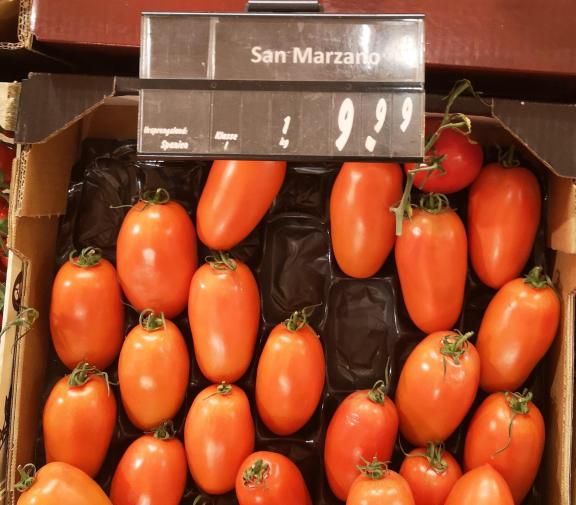
Figure 12: Oxheart tomatoes
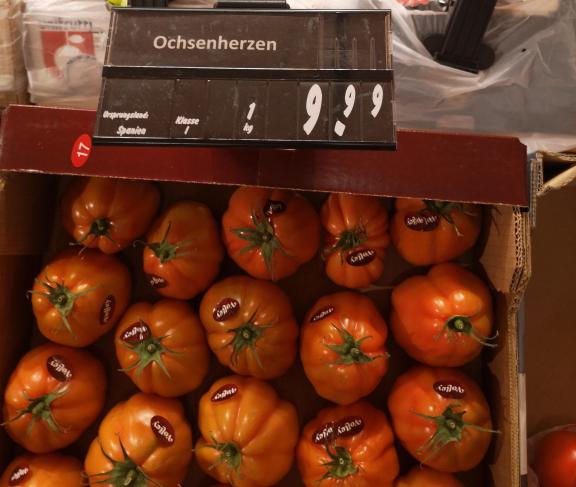
Source: Autentika Global
According to industry insights, common round tomatoes are still popular due to their lower prices. However, sales of other types are increasing despite the higher prices. There is a demand for cherry on vine plum cultivars (e.g. roma, tiger plum, datterini), ribbed tomatoes (e.g. Marinda, Purple Star), plum tomatoes (e.g. San Marzano), extra large tomatoes (e.g. Cor de Bou, Rosamunda, Huevo de Torro, Goutini by ASDA), black tomatoes (e.g. Sweet Marmande, Adora, Kumato, Raf Azul) and mixed colour cherry tomatoes.
Consumer perceptions are very important when selling tomatoes in Europe. Consumers that are dissatisfied with the taste or texture do not buy the same variety or brand again. According to a recent presentation of consumer tomato preferences by Normec Foodcare, Dutch consumers prefer locally grown beefsteak tomatoes over the same type of tomatoes from Spain. Surprisingly, the Spanish tomatoes were sweeter but had more spoilage and a tough skin. This resulted in lower scores than local tomatoes. Moroccan tomatoes were perceived as more acidic than European tomatoes. However, Moroccan tomatoes are improving in taste, and consumers like Moroccan snack tomatoes.
Therefore, it is not only a good taste that counts but rather, the overall impression. In consumer tests, soft and mealy tomatoes received harsher criticism than those with bland tastes.
Tips:
- Consider investing in protecting the origin of specific tomato varieties in your country if they have unique characteristics.
- Consider investing in taste research to discover what attributes and cultivars European buyers in specific markets prefer. If this is too expensive, consider purchasing available studies by the specialised European taste research companies.
Convenient but sustainable packaging
Reducing packaging waste is one of the key trends in the European fresh fruit and vegetables market. According to the German Packaging Institute, approximately 70% of German consumers have declined purchasing a product due to the unsustainability of the product’s packaging. This consumer attitude puts pressure on European tomato suppliers, as the tomato is still the most packaged vegetable type in Europe. Many retail chains are now implementing strategies to reduce plastic packaging.
The aim of the upcoming European Directive on Packaging and Packaging Waste is to make all packaging in the EU reusable or recyclable by 2030. This is a practical implication for tomato suppliers from non-European countries, as this aim includes all packaging that enters the EU. Since the beginning of 2022, France has banned plastic packaging for fruit and vegetables if the total weight is less than 1.5 kg. The law will be applied gradually until 30 June 2026.
In order to reduce packaging waste, tomato suppliers and retailers in Europe have started to offer sustainable cardboard packaging, not wrapped in plastic foil. The new sustainable and convenient packaging by German retailer Aldi Süd was introduced recently. Another example is the Belgian tomato supplier Stoffels. Stoffels invented a vending machine for cherry tomatoes in collaboration with PackRight Centre. Consumers can choose the quantity and colour of tomatoes and have them placed in coconut fibre cups.
However, some consumer organisations in Europe believe that even the use of biodegradable and recyclable packaging for fruit and vegetables is unnecessary. For example, Environmental Action Germany (DUH) recently published research on packaging in Germany, blaming several German retailers for ‘greenwashing’. These retailers use claims of ‘recyclable’ packaging instead of selling vegetables in bulk to avoid waste.
Unpacked and reusable packaging for fruit and vegetables is emerging as a trend in the European retail sector. Instead of cardboard, Aldi Süd now offers organic tomatoes in glass fibre trays. By the end of 2025, the discounter chain wants to offer at least 40% of all fruit and vegetable products without packaging.
Tip:
- Participate in the Global Tomato Congress to get an update about market trends and emerging developments in the European tomato market.
Autentika Global for ICI Business carried out this study on behalf of CBI.
Please review our market information disclaimer.
Search
Enter search terms to find market research
